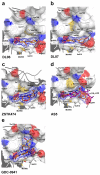The p110 delta structure: mechanisms for selectivity and potency of new PI(3)K inhibitors
- PMID: 20081827
- PMCID: PMC2880452
- DOI: 10.1038/nchembio.293
The p110 delta structure: mechanisms for selectivity and potency of new PI(3)K inhibitors
Abstract
Deregulation of the phosphoinositide-3-OH kinase (PI(3)K) pathway has been implicated in numerous pathologies including cancer, diabetes, thrombosis, rheumatoid arthritis and asthma. Recently, small-molecule and ATP-competitive PI(3)K inhibitors with a wide range of selectivities have entered clinical development. In order to understand the mechanisms underlying the isoform selectivity of these inhibitors, we developed a new expression strategy that enabled us to determine to our knowledge the first crystal structure of the catalytic subunit of the class IA PI(3)K p110 delta. Structures of this enzyme in complex with a broad panel of isoform- and pan-selective class I PI(3)K inhibitors reveal that selectivity toward p110 delta can be achieved by exploiting its conformational flexibility and the sequence diversity of active site residues that do not contact ATP. We have used these observations to rationalize and synthesize highly selective inhibitors for p110 delta with greatly improved potencies.
Figures




Comment in
-
PI(3) kinases: revealing the delta lady.Nat Chem Biol. 2010 Feb;6(2):82-3. doi: 10.1038/nchembio.305. Nat Chem Biol. 2010. PMID: 20081818 No abstract available.
Similar articles
-
PI(3) kinases: revealing the delta lady.Nat Chem Biol. 2010 Feb;6(2):82-3. doi: 10.1038/nchembio.305. Nat Chem Biol. 2010. PMID: 20081818 No abstract available.
-
Structural, biochemical, and biophysical characterization of idelalisib binding to phosphoinositide 3-kinase δ.J Biol Chem. 2015 Mar 27;290(13):8439-46. doi: 10.1074/jbc.M114.634683. Epub 2015 Jan 28. J Biol Chem. 2015. PMID: 25631052 Free PMC article.
-
Structural insights into phosphoinositide 3-kinase activation by the influenza A virus NS1 protein.Proc Natl Acad Sci U S A. 2010 Feb 2;107(5):1954-9. doi: 10.1073/pnas.0910715107. Epub 2010 Jan 19. Proc Natl Acad Sci U S A. 2010. PMID: 20133840 Free PMC article.
-
Structural Determinants of Isoform Selectivity in PI3K Inhibitors.Biomolecules. 2019 Feb 26;9(3):82. doi: 10.3390/biom9030082. Biomolecules. 2019. PMID: 30813656 Free PMC article. Review.
-
The regulation of class IA PI 3-kinases by inter-subunit interactions.Curr Top Microbiol Immunol. 2010;346:87-114. doi: 10.1007/82_2010_52. Curr Top Microbiol Immunol. 2010. PMID: 20544340 Free PMC article. Review.
Cited by
-
Germline recessive mutations in PI4KA are associated with perisylvian polymicrogyria, cerebellar hypoplasia and arthrogryposis.Hum Mol Genet. 2015 Jul 1;24(13):3732-41. doi: 10.1093/hmg/ddv117. Epub 2015 Apr 8. Hum Mol Genet. 2015. PMID: 25855803 Free PMC article.
-
Identification of mammalian target of rapamycin as a direct target of fenretinide both in vitro and in vivo.Carcinogenesis. 2012 Sep;33(9):1814-21. doi: 10.1093/carcin/bgs234. Epub 2012 Jul 12. Carcinogenesis. 2012. PMID: 22798378 Free PMC article.
-
A highly potent and selective Vps34 inhibitor alters vesicle trafficking and autophagy.Nat Chem Biol. 2014 Dec;10(12):1013-9. doi: 10.1038/nchembio.1681. Epub 2014 Oct 19. Nat Chem Biol. 2014. PMID: 25326666
-
Discovery of a Potent, Selective, and Orally Available PI3Kδ Inhibitor for the Treatment of Inflammatory Diseases.ACS Med Chem Lett. 2016 Nov 30;8(1):118-123. doi: 10.1021/acsmedchemlett.6b00438. eCollection 2017 Jan 12. ACS Med Chem Lett. 2016. PMID: 28105286 Free PMC article.
-
PI3K isoform-selective inhibitors: next-generation targeted cancer therapies.Acta Pharmacol Sin. 2015 Oct;36(10):1170-6. doi: 10.1038/aps.2015.71. Epub 2015 Sep 14. Acta Pharmacol Sin. 2015. PMID: 26364801 Free PMC article. Review.
References
-
- Vanhaesebroeck B, et al. Synthesis and function of 3-phosphorylated inositol lipids. Annu Rev Biochem. 2001;70:535–602. - PubMed
-
- Sundstrom TJ, Anderson AC, Wright DL. Inhibitors of phosphoinositide-3-kinase: a structure-based approach to understanding potency and selectivity. Org Biomol Chem. 2009;7:840–850. - PubMed
-
- Miled N, et al. Mechanism of two classes of cancer mutations in the phosphoinositide 3-kinase catalytic subunit. Science. 2007;317:239–242. - PubMed
Publication types
MeSH terms
Substances
Associated data
- Actions
- Actions
- Actions
- Actions
- Actions
- Actions
- Actions
- Actions
- Actions
- Actions
- Actions
- Actions
- Actions
- Actions
- Actions
Grants and funding
LinkOut - more resources
Full Text Sources
Other Literature Sources
Chemical Information
Molecular Biology Databases
Research Materials
Miscellaneous

